Modifications of Easyboot Gloves and Glue-On Shells 5-20-17 Pete Ramey
Since they were
only prototypes in 2008, the Easyboot Gloves and Glove Glue-On
Shells from
Easycare, Inc. have
been my primary tools for hoof protection. There are many great
boots and gluing options out there and I have tried a majority
of them but these have remained my favorites.

Easyboot Gloves
These boots are
light, compact and durable; but the reason I am so fond of them
is that I can modify them in so many ways to suit individual
hooves. This is particularly important with flared or rotated
hoof capsules or hooves with long toe/under-run heel syndrome.
The toe of the boot can be heat-fitted to expand, allowing the
breakover to be placed correctly – critical to correct movement
and thus rehabilitation of these hooves.

Glove shell heat-fitted to a rotated hoof capsule. The breakover will also be modified in the boot tread as needed. Note the "shiny" areas of the boot - a key part of judging the heating process.
That means that
this boot is not for everyone and not for every hoof; however a
well-fit Glove is the highest-performance option, so each owner
must decide whether to go this route. I suppose this is similar
to a racing engine that must be pulled apart and rebuilt after
every race. Is this a good engine? It depends on your
perspective.
As you close
these loose areas, you will simultaneously be optimizing
breakover and placing the heels in the perfect spot to be snug
(but not overly tight) and sitting all the way down on the boot
floor (not standing on the heel portion of the shell or the
gaiter).
Remove the boot from
the horse for the heating process, and be careful to direct the
heat away from the gaiters (and your hands). Only the lower
shell is heated. You need to heat the boot gradually, so it
heats all the way through. The timing varies daily with the
power source, heat gun, ambient temperature, and the temperature
the boots endured in the back of your truck the previous night.
So each time I heat boots, I must determine a new timing. I do
this by seeing how long it takes the area I’m heating to develop
a sheen.
On the outside of
the boot, hold the heat gun parallel to, and ¾” away from the
surface, moving the heat gun in small rapid circles to
distribute heat. As soon as you see a slight sheen appear on the
surface, move the heat quickly to another area. Keep the heat
focused only on the tight areas you previously marked, trying to
avoid heating areas that were already loose on the hoof wall.
Once you have brought a slight sheen to the desired areas on the
outside walls of the boot, switch to the inside of the boot. You
will not be able to focus heat as accurately or see the sheen on
the inside, but instead, apply heat for the same amount of
time as you did on the outside. Repeat one more time
inside and out for the same amount of time as it took to develop
the sheen in the first lap.
Caution: In
used boots, you will not see the sheen develop. Ground-in dirt
hides the sheen until the boot is over-heated. Learn today’s
timing on a new boot before trying to heat up a used one.
If, at any point in
the heating process, you see tiny bubbles emerge on the surface,
move on from that spot and don’t return – that area is slightly
over-heated (but may still need more heat from the inside of the
boot).
After this process
is complete, move quickly to the horse and put the boot on. You
may need a rubber mallet to drive the boot back far enough. When
the heels are in the perfect spot in the boot, put the foot
down, let the boot cool for two minutes, and evaluate your fit.
The key to Easyboot Glove success is at the heels. If the heels are too tight, the boot will be constantly trying to “squirt off” the foot (plus heel rubbing is likely, as is gaiter failure). If a mallet is required to put the boot on, the heels are probably too tight. The boot should slide on readily in hand.
If the heels are
too loose, the foot can twist in the boot. If it can twist with
hand pressure, it will twist when you ride. So to combine these
two extremes, the perfectly fitted Glove will slide right into
place with firm hand pressure (minimal percussion), but then
“suck” into place with no turning of the boot on the foot.
Secondary to heel
fit is the percentage of boot wall touching the foot. Ideally,
the boot will be touching the hoof wall everywhere with no air
spaces. But this perfection is sometimes impossible to achieve –
particularly with wide feet or feet with large quarter flares.
The boot can perform well with about 30% airspace, but always
strive for “the best you can get.” At this point, I often reheat
small, tight areas to close more air spaces, particularly at
quarter flares.
I fit hind feet the
same way, but it usually looks very different. Hind feet
tend to be more pointed than the rounder front feet. The
Gloves (and all other hoof boots) were designed to fit the front
feet. This is why hind boot fit issues are so common, and this
is where the Gloves can really shine. I generally pick a
hind boot size by its width. This usually means the foot is way
too long for the selected size. I then heat the center of the
boot toe, allowing the horse’s more pointed hind toe to hang
over the front of the boot, much like a laminitis case. This, of
course, locks the foot in place within the boot, preventing the
twisting so common with hind boots.
Sometimes, by the
time you get the toe area fitted, the heels have become too
loose. This boot will not function well because the heel fit is
the most important aspect. You simply need to go down a size (or
two) and start over. This is not a big deal for professionals,
who can simply sell the other boot to someone else who needs
that size, but can be really bad news to a horse owner who has
one horse and one set of Gloves. With experience, you can learn
to prevent this (usually) by simply thinking things through
before you heat. If, during the initial assessment, I see that I
have significant changes that need to occur at the toe, but my
heels already fit nicely, I automatically know I need to start
with a smaller size.
It usually
works well to size the boot for the width the foot would
be if there were no quarter flares, and then heat-fit to
accommodate toe length and any wall flares. At best, with
distorted feet, this will take some experimentation, so it is
always best to have several different sizes around to simply try
on.
Like your own
shoes, horse boots adapt to the foot with use. For best results
and performance, designate one boot to one foot (I “earmark”
them with nippers and/or a hole punch, as writing on them
doesn’t last). While this will help with the performance of any
boot model, it is particularly critical with the Gloves. If you
need to share boots between horses, I recommend you choose a
different model – one with buckles, straps and overlapping
layers of materials.
The most common
modification I make is the addition of padded insoles to the
boots. This puts the sole, bars and frog to work, thus relieving
strain on the laminae and provides a cushier ride to the solar
corium. A weakness of the Gloves (vs. some other models) is that
they generally won’t accommodate pads thicker than 3/8-inch.
When I need thicker padding for extreme rehab cases, I use a
different model.
But for most horses,
1/4”-3/8” pads are all we need, and these work well in the
Gloves. A wide array of pad choices are available – your
imagination is the limit – but the best pad is the one that
makes the horse feel the best and move more correctly.
Particularly with lameness cases of any kind, it is wise to
experiment with multiple pad choices and pick the one that
yields the best movement of the horse.
I am a big fan of
the
Easycare Comfort Pads
(as I should be, since I
originally picked out the materials). They come in two
thicknesses and three densities that cover most needs. It can be
a big money-saver, though, to find large quantities of raw
foam/rubber from other sources. Horses with thin or otherwise
painful soles tend to choose this type of padding over other
options.
Another favorite
of mine is synthetic felt in 1/4" or 3/8” thickness (thanks
Sossity and
Mario). Horses
with caudal foot pain tend to prefer these. They are also better
for moisture management, so I really like them for boot turnout
and in glue-on shells. Sourcing the material has been a bit of a
problem. It is readily available online but seems
extraordinarily expensive. So far, I have continually found new
saddle pads and
liners at clearance sales for my own use, and I am always
sticking my nose into clients’ tack rooms looking for a deal on
an unwanted felt saddle pad. I have also found the thick (1”-1
½”) felt pads can be easily cut/torn into thinner pads, as the
material is put together in layers.
Some horses show
no preference between the foam/rubber pads and synthetic wool
felt. For these, I tend to use the felt, as it is cheaper, more
durable (always a good combination), and may manage moisture
better.
Thick leather is
another durable pad choice. Go to a leather shop and buy tanned,
full thickness cowhide. These pads offer less shock absorption
so may not be the best choice for most thin-soled horses. But
for sound horses that you simply want to provide more load
distribution, leather is a great choice. I also prefer leather
when I need to unload an area of the sole by cutting a relief
hole in the insole. This comes up with surgery sites on the
bottom of the foot, and with “sole penetrations” or other
exposures of the solar corium.
Regardless of the
material selected, you will need to cut it to shape. With
Easyboot Gloves, I place the boot on the pad material with ½” of
boot heel tread hanging off the edge of the pad. Then, using a
Sharpie, I trace the boot outline onto the pad. I cut the pad
with large shears or a razor knife, following the inside of my
mark, leaving the mark and 1/8” of extra material on the unused
portion of the pad. The desired end result is a pad that fits
the inside of the boot well, with no wiggle room, and no lapping
up onto the sides in any area.
These
are stretchy rubber additions to the top of the Glove boot, available as add-ons
from Easycare. They are very handy for eliminating boot fit/performance issues,
but they do make boot application more difficult for the average horse owner.
When I first started using the Gloves, I knew nothing about heat fitting them
and found I needed Power Straps on about 20% of front feet and 80% of hind feet.
As I got better at heat-fitting, I use about two sets per year.
Their best use
may be for economy. When you fit Gloves to a flared or rotated
foot and then succeed in growing in better-connected walls, the
foot size is generally smaller. This means the boot fit will
have become loose and sloppy. The correct thing to do at this
point is fit a new set in a smaller size but adding the
Power Straps can be a
cheap alternative that extends the life of the old boot.
Power Straps come
with cut and punch marks labeled for each boot size. I have
found that, rather than using these marks literally, I do better
thinking my way through it and punching the holes where I think
they need to be for the individual fitting needs.
As an extension
of the Power Strap idea, you can add buckles to the boots to
gain even more adjustment. The buckles in the picture below are
replacement buckles for O’Neal motorcycle boots I ordered from
Amazon. Of course this eliminates some of the compact nature I
love about the Gloves, but the result is still more compact than
most types of boots.

Replacement buckles for O'Neal motorcycle boots I ordered from Amazon (part #0290-095 and #0290-091) added to the Power Strap attachment points. Apply buckles so that they are on the lateral sides of the boots to avoid interference.
In other models of
boots, I usually drill drainage holes in the sole to quickly
drain the boots after creek crossings. Due to the close fit of
Gloves, particularly if insoles are being used, I find there is
no need to do this – there is not really any room for sloshing
water in the well-fitted Glove. But opinions (and fitting) vary,
so if you feel the need to drill drain holes in your boots,
there are certainly no problems with it. I generally like to use
a ½” drill bit and place multiple holes in the tread over any
open areas inside the boot. This hole size seems to be a good
compromise – large enough to resist clogging and small enough to
minimize the entry of pebbles.
By nature, Easyboot
Gloves are probably more sensitive to a tight trim cycle than
other models. This works to some horses’ advantage because boots
have been used by many owners as a tool to allow neglect.
The boots should be fitted to a freshly trimmed foot. There is generally enough stretch in the Glove shells to accommodate a six-week trim cycle if there is minimal wall flaring on the hoof. But for horses with significant wall flares, the foot gets much larger in circumference during the trim cycle. By six weeks, you usually will not be able to get the Glove on. These horses will need a shorter trim cycle until most of the flaring is successfully grown out – but again, this is a good idea, anyway. It is worth noting, though, that the bulkier types of boots with buckles and overlapping layers of materials will be more accommodating to long trim cycles on flared hooves. The Gloves aren’t for everyone.
The stock bevel
built into the toe of the Glove is generally just right for
horses with perfect wall attachment at the toe except that since
horses need to turn, I feel that same shape should continue from
a 10:00 to 2:00 position around the toe. This modification, I do
to almost every pair I fit. I use a brand new Heller Legend hoof
rasp that has never trimmed a foot or a coarse Cody James
Dymondback for this (and most other
modifications to the boot soles). Many types of sanders and
grinders work well, too – your choice.
In horses with
separation of the toe wall from the coffin bone, I generally
accommodate most of the needed breakover adjustment with
heat-fitting of the boot’s toe, but an additional inch of
breakover change can be trimmed into the boot sole as well. This
is handy for joint, muscular and other problems with locomotion
as well.
There are countless
reasons (I won’t go into here) that rockering of the heels can
create an advantage for the horse – club feet, forging issues,
chronic toe-walkers, joint problems, caudal foot pain, hoof
capsule rotation to name a few. I often do this, both to bare
feet and to any appliance I add to the foot, including hoof
boots. The Gloves accommodate this very well.
Occasionally,
there is a therapeutic need for mediolateral or dorsopalmar
wedging of the foot. If no more than 3/8” of deviation is
needed, I prefer to simply remove the unwanted material from the
boot tread. If more were needed (rare), farrier wedge pads (up
to 3/8”-thick) can work in the Gloves.

At 2:00, the typical rounding of the breakover I do to most Gloves and Glue-Ons. Additional breakover adjustment can be added - I often rasp it back to the second traction groove at the toe, taking care not to rasp up to the tiny seam between the boot tread and the sidewall.
At 7:00, I have added a typical heel rocker I like for chronic toe walkers, hoof capsule rotations, and some club feet. This shape and size can very as needed. Center, is a common vent I do (discussed below), only to Glue-Ons - not Gloves. This is a size #1.5 and the hole was made with a 2 1/4" hole saw, arbor and drill.
Two types of
add-on studs are available from Easycare – a
large nut/bolt type stud
and smaller
ice screws. I have
also experimented with using a larger hole saw to drill out and
open the bottom of the boot, leaving a narrow rim of shoe at
ground level and an exposed sole. This gets great traction in
muddy and most arena conditions but may have the same
disadvantages of a thick metal shoe; clogging and carrying too
much weight of dirt, which could limit performance and hasten
fatigue.
A better
modification for deep or muddy footing is to use an electric
router and guide to thin the boot tread to ½” wide. Next, heat
up the remaining boot sole and push it up into a dome shape (I
press the boot sole onto one of my daughter’s softballs to
achieve this shape. The prototype traction sole shown below was
simply a computer duplication of a Glove shell I modified in
this fashion.
The idea (much like
a bare foot) is that the tread will clean out with every stride
(spray with WD-40 or Pam for better results). I believe that
these get better traction on mud, wet grass, arena surfaces,
tracks, etc. than cleat-type treads or a metal perimeter shoe
because of this resistance to clogging. An additional advantage
from a performance standpoint is not carrying the added weight
of the dirt/mud.

Traction modification for deep footing. Be sure to leave an adequate "shelf" for the toe to stand on. Because of the increased likelihood of gripping the ground too well or snagging on something, use this with Glue-On applications or with Mueller Tape added to a Glove as discussed on pages 16-19. Also, of course, consider the safety of the horse - this is suitable for loose arenas or tracks but not trail work.


Prototype Glove traction sole. You can build one from a standard Glove (except that outer rim of tread will be slightly more shallow) using a router with a guide and square bit, a heat gun, and a softball.
This boot will, of course, wear out faster on hard terrain but as with human athletic cleats vs. track shoes, I don't think it will ever be possible to optimize turf traction with the same tread pattern that is perfect for road work. For top-level performance, you will need to own both.
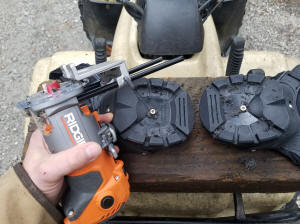
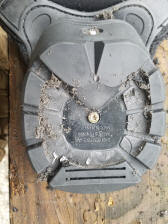
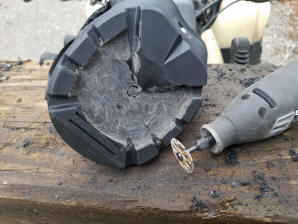
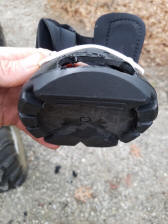
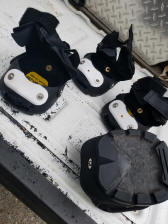
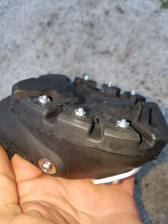
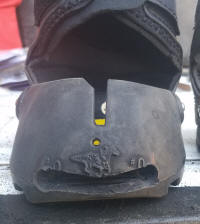
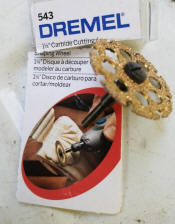
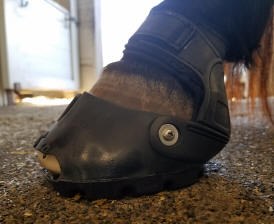
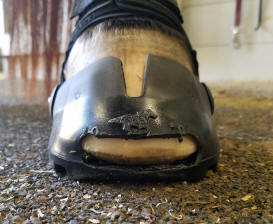
Toe slots are a useful trick for accommodating the more
pointed shape of hind feet, for some extreme laminitis cases,
and for stabilizing boots on performance horses. The slots
really lock the foot in the boot, making them particularly
effective for horses that tend to run out of their hind boots
when cantering uphill. I have also used toe-slotting
successfully for extreme heat fitting, as in stretching #0
Gloves to #2.5 lengths for riding mules.
I start by drilling 1/2” (12mm) holes wherever I choose for
each end of the slot to be. Self-tapping, wood boring (brad
point) bits seem
to work best. The size and location of the slot varies with hoof
shape and with how much toe I think needs to hang past the boot
tread. To stabilize boots on normally-shaped feet (where no toe
needs to hang over the tread) I make the slots narrow – usually
about 2” (5cm) wide or less.
Then, using a Dremel 543 carbide cutting wheel (and safety
glasses), I connect the holes. Don’t try to make these cuts
tangent – instead be sure that each cut hits the side of the
drilled hole, making sure that the cut doesn’t run past the
drilled hole at all. Doing so would create a starter cut from
which the boot material might rip. Make the bottom cut level
with the boot floor and the top cut sloping downward in the
middle. After heat fitting the foot in the boot, the center cut
will become pushed up, yielding a more parallel slot as a
finished product.
The Gloves are
designed and intended for riding and other work, with the
assumption that the boots will be removed when the horse is
turned out. In spite of that fact, after trying countless other
products, I have found Gloves are my favorite turnout option for
horses that are temporarily lame in their own turnout
environment. Boot turnout is no picnic for the horse owner –
there is work involved – but, in my experience, padded boots
tend to provide more pain relief and quicker healing than any
other shoeing option. If increased movement and a lack of
compensative movement are achieved while simultaneously “doing
no harm,” the result is healthier growth of every part of the
foot. So boot turnout tends to be the quickest path to feet that
are healthy enough to be comfortable barefoot in their own
turnout environment.
This is most
critical with laminitis cases. Only in a padded boot (or
sometimes bare on the most perfect terrain) can you hope to get
away with unloading the walls (and thus the laminae), carrying
the load on the sole while healthy laminae are re-grown. This is
because only boots offer a full release of pressure to the sole
(thus the solar corium) when the hoof is in flight.
The primary reason I
like the Gloves best for turnout is that with heat-fitting, I
can adjust breakover to the correct area on horses with flared
or rotated walls – a key feature of most horses who are unsound
at turnout. For caudal foot pain cases, assorted pads can be
tried in the boots to achieve flat or heel-first impacts – the
key secret to success with these cases. The Glove tread readily
accepts modification, as discussed above, often critical to
rehab cases. In my experience, a well-fitted Glove is less
likely to cause rubbing of the bulbs or hide than any other boot
I've used. All this and more can be done in a lightweight, very
compact package, which also very important to me.
Turnout is hard on
boots. Constant exposure to UV rays break down the nylon and
plastics. Generally the same boot that might last an endurance
rider 450 miles (or the average trail rider five years) will be
destroyed by 2-3 months of turnout. The Gloves are no different
except the only part that gets destroyed is the gaiter.
Replacing the gaiter is much cheaper than buying a whole boot.
Note: Gaiter life
is greatly extended by wrapping the gaiter with
Vet Wrap (or other
tape) when using the Gloves as turnout boots. It blocks UV rays,
and helps prevent horses from nibbling on the Velcro closures.
The Gloves do also
have weaknesses as turnout boots, compared to other models. Some
cases will need thicker padding than the Glove can accommodate.
I use up to ½”-thick pads in Gloves on lame (lower performance)
horses, and it works pretty well. But if you need thicker
padding, you will need to select a different boot model.
Another issue
already discussed is that with the Gloves, you are more likely
to need 2-3 boot sizes as you grow out a 20+ degree rotation
than if you were using a boot with buckles and layers of
overlapping material. But since you generally can’t get
breakover right on a rotated foot with those other types of
boots, I feel you are much more likely to grow out a
rotation if you use heat-fitted Gloves. The extra money
is well-spent.
Regardless of the
boot you choose for turnout, the primary problem is the rotten
“funk” that quickly builds up inside the boot. This can
complicate infections in the white line and frog. It can also
get in the way of growing a healthy sole, which is one of the
key features of a horse that can be sound for barefoot turnout.
To eliminate these problems, the boot must be removed and washed
daily. During this time, clean the horse’s feet and place him in
a dry area suitable for whatever problem he has (deep shavings,
a deep bed of pea rock, etc.).
During this time,
inspect the bulbs and legs for rubbing. If this occurs, it is
probably because the boot is too tight at the heels (jamming),
or too loose (twisting/movement is occurring). Re-fit your boots
and/or bandage or use a man’s tube sock on the horse prior to
booting.
After – ideally –
two hours of drying time, powder the inside of the boot with
Gold Bond Medicated Foot Powder
(available from most pharmacies) and
replace the boots. Re-wrap the gaiters with Vet Wrap (or other
tape).
Yep, this is a lot
of work for the horse owner. But for many problems, particularly
laminitis and caudal foot pain/navicular syndrome it works
better and is way-cheaper than any shoeing option I know
of. I expect/demand horse owners with a horse with the above
problems to give me 2-3 months of good boot turnout. During this
time, my goal is comfortable, non-compensative barefoot turnout.
If I cannot achieve this, I let the horse owner off the hook and
seek other options.
Some problems are
permanent. Others may take years to fix. This is when I reach
for glue-on shoes. The healing rate is slower, compared to
booting, but the daily maintenance by the owner is more
reasonable for the “long haul.”

In my opinion, the
increasing popularity of synthetic shoes – both for rehab and
for high performance – is a very good step in the right
direction. During the time that metal was the only material we
had that would hold up under a horse, metal made a lot of sense
as a horseshoe material. But these days we have a wide array of
materials that will do the job, and most of them are much better
for energy dissipation and shock absorption. These materials are
also more flexible, which can allow the foot to function more
normally, probably leading to increased health of internal
structures and increased protection from internal and external
injury.
I do worry that
synthetic shoes will become just another thing that people leave
on horses’ feet 365 days a year. Healthier than steel, perhaps,
but still degrading the foot with their constant presence. I use
these tools in my everyday work, but for most situations I
remain a “barefoot and boot man,” as I think this combination
yields the best hoof health in a majority of situations.
There are
times, though, that long-term or even permanent hoof protection
is needed. For these horses, I usually turn to the Glove Glue-On
Shells (simply a Glove without the
gaiter) instead
of other synthetic shoe models for several very specific
reasons:
•
All of the glue bond is on the side wall, instead of on
the bottom of the wall. This frees me up to unload areas of
separated walls, making these shoes ideal for growing out hoof
capsule rotation, toe flaring, and quarter flares (and thus wall
cracks).
•
There is no need to trim the foot “flat” in preparation
for shoeing. The horse’s foot, when viewed from the side, is
naturally arch-shaped, mirroring its internal structures. The
only ways to level this arch for shoe prep are to, 1) thin the
sole at the toe, 2) thin the sole at the heels, 3) leave the
quarter walls too long, or some combination of those three. I
can’t abide any of those, as each causes damage. Note: When
floating the quarters above the shoe floor, be careful not to
let glue run beneath the wall and harden under the sole.
•
Almost as well as a hoof boot, if
applied properly, they can allow total release of pressure to
the sole during hoof flight. This allows you to get away with
more sole pressure/support than any other fixed shoeing method I
have seen, heard of, or tried.
•
The glue bond area is 3-5 times larger than typical
glue-on shoes. There is also no need to prep (or protect the
prep of) the ground surface of the foot. For beginners, this
makes it easier to succeed with them. For seasoned veterans,
this makes the bond as close to bombproof as a shoe can get.
•
I can pad in them! Most permanent shoe
modifications accommodate padding or impression material under
the arch of the sole, but not under the wall or the outer
periphery of sole. This little trick is a true life-saver for
thin-soled, splat-footed horses.
•
Using heat-fitting, this shoe can easily adapt to any
almost any hoof shape, and be adapted to any breakover or heel
support needs.
•
Economics. I can stock only this shell and, by trimming it
down to shape, duplicate a wide array of products. If I want an
Easyshoe, a Flip-Flop, Love Child, a lower cuff, a direct glue
shoe with no cuff, M/L or D/P wedge, better traction, heels in,
heels out, open sole, closed sole, frog support… I can make one
by removing unwanted material from this single product. This
helps maximize precious storage space in my truck and, of
course, dramatically cuts the expense of carrying so many
products.
It is
equally important to achieve a proper fit with the Glue-Ons as
it is with the Gloves. We have the same breakover and heel
support needs. Large gaps between the wall and shoe will be
difficult to fill with glue, and tight areas may push the shoe
out of place before (or after) the glue dries.
Better fit can be
achieved with the Glue-Ons than the Gloves when large quarter
flares are present since the gaiter is not in the way of quarter
fitting. During the heating process, you will find that it is
better to hold the shell with something besides your hand,
particularly if you have opened the sole (discussed below). I
use my shoe pull-offs or crease nail pullers.
As an end result,
you want a snug but relaxed fit with little-to-no air space, and
no pressure attempting to push the shoe out of place. Prior to
gluing, you should be able to put it on the foot with no glue,
walk the horse around on concrete, and it should stay in place.
All of the
modifications I discussed on the previous pages with the Glove
boots can also be done to the Glue-On Shells. Below are
additional options I use only when gluing.
Gluing allows you to
cut out the heel section of the boot completely. I almost always
do this as it allows the foot to breathe, keeping the back half
of the foot relatively free of the black, foul funk. I
tend to do this simply with my pocket knife, and then I finish
by rounding the top of the cuff with my nippers or shears.

Opened heel of Glove shell, done with knife and nippers with stock shell in background. I'm doing this to 90-something % of my glue-on shells. Note: more recently, I discovered a great new tool for this and other detailed trimming of the shell walls - Wiss 7" Spring Loaded Utility Shears.
If there is
adequate sole and frog in the center of the foot and if I don’t
perceive a need to use impression material or padding, I often
vent the bottom of the shoe (as shown in the photo on page 8).
Using a jigsaw or Dremel, you can follow the contour of the shoe
tread, mimicking the frog support and look of an Easyshoe. The
material is strong and difficult to cut. Most tools actually
burn their way through it, rather than cutting, and it can be a
long process.
So in most cases,
I simply use a drill and hole saw (thank you
Leslie
Carrig!), usually 2 ¼”
diameter, occasionally larger, to vent the bottom of the foot.
This takes seconds to do, with no burning or clogging, though
the end result may not look as cool as other designs, the horses
never notice. As with almost any open-bottom shoe, there is some
risk of a stone lodging between the shoe and the sole, causing
problems. But the access to air can be worth the risk,
particularly if the owner routinely picks and checks the area.
All of the
padding methods discussed for the Glove boots will work with the
Glue-On version, plus several additional options -- Dental
Impression Material (DIM),
pour-in pads, and
Sikaflex 227 adhesive,
to name a few. Generally, when using
any type of pad, I leave the shoe’s stock sole intact (forgoing
the sole vent). I also fill the frog’s central sulcus, the
collateral sulci and cover the sole with a thin layer of
Evo
Thrush or
Artimud to keep
infection at bay.
Gluing
instruction is best done in person or at least via DVDs or
YouTube (start
here) – not in
writing – but here is my basic protocol in a nutshell, and in a
very specific order:
1.
Trim the feet, clean
out any infected areas in the white line or frogs, wire brush
debris from the walls and bottom of the foot. This, and the
other steps are each done to all four (or two) feet that are
being glued in sequence, rather than doing each foot
start-to-finish. This saves time.
2. Heat-fit and do all shoe modifications. If using DIM or a felt pad, it is prepared at this point. If using a pour-in pad, decide if you need a hole or holes in the shoe to inject the pad.
3. Sand all the gluing surfaces of the sidewall, yielding a rough finish. I cut 50 grit belt sander belts into small squares and do it by hand, or more recently, use a cordless drill buffer/sander. Take care to prep all the way to the back of the heels. This area can be hard to reach, easy to forget, and is the most critical area of glue bond.
4. Using the butane mini torch linked below in step 5, heat the sole, frog, bars, central sulci and collateral sulci -- this is brief heat application (1-2 seconds to each surface) that accomplishes critical drying and sanitation prior to covering these areas. Then immediately apply Evo Thrush (antimicrobial clay) into the central and collateral sulci. Use a rubber glove, discarding it immediately afterwards, being very careful not to contaminate your gluing areas with the oily medication. Doing this step well, particularly when combined with impression material or a pour-in pad, makes a dramatic difference with foot hygiene by the end of the shoeing cycle.
5.
With a
small hand-held butane torch,
and keeping the visible flame out of
contact, I heat the outer wall for 1 or 2 seconds in each
individual spot, moving the torch around very quickly while
avoiding melting the hair at the coronet. Most of this, I do
with the foot on the ground, but be sure to pick up the foot and
prep the heels. I do the same to the inside of the shoe’s gluing
area. This step eliminates dust, oils, and moisture, and is
critical to success. After this step, take great care not to
re-contaminate the glue surfaces of the hoof and shoe. Arm
sweat, oils from impression materials and fungal/bacterial
treatments are the most common culprits, as well as the grubby
little hands of curious onlookers and well-meaning horse owners
with a bottle of fly spray in hand (yep, it happened to me).
6. Using a painter’s digital moisture meter, verify that all parts of the hoof’s gluing surface read 0.0% moisture. If not, repeat step #4. If a horse just came in from dry stall shavings or a dry pasture, one lap with the torch will usually do the trick. If the horse just came in from the rain and was towelled dry, it may require three to five laps. Resist the temptation to heat longer as this could harm the horse. Instead, heat more times. Be patient – this is the most important step, particularly if you live in a damp climat. In dry climates, even if the surface reads 0.0% before prep, still do the torch step at least one time -- you still need to fry dust and remove the surface oils, etc.
7.
Glue. Keep it warm in
winter, cool in summer (70 degrees F). I like to use the
guns and mixing tips
– personal preference. Sometimes I use the acrylic,
Easyshoe Bond Fast Set (or
Equilox, Equibond – all the same, with different labels) because
it may be better glue for wet environments, and sometimes I use
the urethane
Vettec Adhere because
it is less noxious and may do less damage to the walls (better
for multiple back-to-back shoeing cycles). Adhere
is also more user-friendly, and thus may be easier for beginners
to succeed with.
8.
Purge the glue before
installing the tip. For Adhere, be sure equal amounts of both
agents are flowing freely. For Easyshoe Bond Fast Set (Equilox
II), be sure
the (white) bonding agent is flowing constantly, about 1/10th
the volume of the pigmented agent. If so, wipe the glue from the
end of the tube, being careful not to mix the agents, and apply
the mixing tip.
9.
If using DIM, place
it on the foot. If using felt (or other) pads, place them in the
shoes.
10. Purge a grape-sized ball of glue onto the ground or paper towel, then apply the glue to the shoe. I avoid the sole, the ground surface of the wall, and the lower ½” of the cuff. The concern here is getting a glob of glue on the sole, which will then act as a stone in the shoe. To the rest of the cuff, I apply the glue liberally with a continuous ¼”-thick bead covering most of the gluing surface by the time I am done. In warm weather, I then put the shoe on immediately. In cold weather, I may stall for a bit, waiting for the glue to begin to cure. I repeatedly touch the glue with my gloved finger – at first the glue will attach a small “string” as I pull my finger away. As the glue starts to cure, this will not occur, and it is time to apply the shoe. As you do this, be careful not to drag glue from the sidewall onto the sole.
11.
Wait. For some applications, I want to
cure the glue while I am holding up the foot (less sole
pressure, less compression of pads – I generally do this on
thin-soled or laminitic horses, as it ensures a 100% release of
sole pressure whenever the foot is in flight). On other
applications, I cure the
glue with the foot on the ground (easier for lame or impatient
horses; may yield a more snug “performance fit” - I often do
this on endurance horses with great feet).
If the shoe is to be
cured unloaded, put the shoe on, put the foot down on the
ground, have an assistant pick up the off foot, then quickly put
it back down (this spreads any glue that might have accidentally ended up on
the sole). Pick up the foot you are gluing, check shoe
placement, wipe off any excess glue, then hold the foot up until
the glue dries.
If the glue is to be
cured with the foot on the ground, place the shoe, have your
assistant pick up the off foot, and then watch the glued foot
carefully as the glue dries. At some point partway through the
cure, I switch places with the assistant, as I will want to be
the one holding the foot during the latter (and more trying)
minutes of the cure.
12.
Repeat for the other feet. You will
need to clean, purge, and apply a new mixing tip for each shoe.
13.
Go around with a hoof pick and check
the shoe heels to be sure they are bonded. If not, attach a new
mixing tip and re-glue these areas. At this point, you can also
seal the tops of the shoe cuff with a thin bead of glue. If you
are slick, you can get all this done to all 4 feet with one
mixing tip.
14.
If you are using
pour-in pads, inject
them now. Decide whether you want a lot of
sole pressure, a little, or none. If you completely cure the pad
while you are holding the foot off the ground, there will be a
lot of support/pressure. If you put the foot down to let the pad
cure, there will be none. It varies case-by-case, but I tend to
do something in-between -- I usually like to see a 1/2" bubble
of pad materiel bulge out the back of my shoe when I first load
the partially cured pad.
15.
![]() When
all the glues are cured, watch the horse move. Make final
adjustments to breakover and heel rockers, as needed, based on
movement. I love the coarse Cody James Dymondback for this.
When
all the glues are cured, watch the horse move. Make final
adjustments to breakover and heel rockers, as needed, based on
movement. I love the coarse Cody James Dymondback for this.
After 5-6 weeks,
Vettec Adhere will become brittle enough that shoe salvage is
not terribly difficult (though it is still cheaper to buy a new
shoe than it is to pay me to clean an old one up for you). I
take a ¼” flathead screwdriver and work it between the shoe and
the hoof, separating the bond.
With Easyshoe Glue
(Equilox, Equibond…) at 5-6 weeks, the glue will not be brittle
– the screwdriver method rarely works. Instead, using my hoof
knife, I cut ½”-long slits in the top of the cuff, dividing the
cuff into 6 sections around the circumference of the foot. I
then use my shoe pull-offs to peel and rip each of the sections
down and off the hoof wall individually.
A hybrid between the
on-off hoof boot and a glue-on application is the tape-on
boot/shoe. Many people trail ride in this setup, and I use it
for rehab cases when I need to cover the foot for 24-48 hours
and then gain access.
Warning: Results of
this vary wildly. If a horse steps on his own shoe, they will
pull right off. But I have also seen them stay on for a week and
heard of them staying on even longer. I think it really depends
on the way the horse moves and perhaps the environment. I have
found that I can count on them for 36-48 hours as well as about
anything – so this is how I use them.
If a horse
absolutely must have 24/7 protection, use a boot or a glue-on
instead. I like to say, “Tape-ons are for when you kind-of
need a shoe and only need it for a short period of time.” All
that said, this is still a very commonly useful tool, and has
the distinct advantage that you can keep re-using the same shell
over and over, often for years to come. This can also be the
only option (for turnout or riding) when the bulbs or coronet
has been injured and permanent shoeing is not desired. This
method also works for use similar to a hospital plate when daily
access is needed to dress a wound or surgery site.
This method is ideal
for post-trim tenderness. A conscientious trimmer (with a stock
of glue-on shells) who inadvertently causes post-trim soreness,
can do a tape-on application to cover the foot for a few days,
then pick up the boots at the next visit, clean them up and sell
them to a gluing client. All it costs is the purchase of the
tape and the time to clean up the boot.


Tape-On Application. Used alone with Glove Glue-On shells or as extra insurance with Glove hoof boots.
Note: For many years I used Mueller's Athletic Tape for this. But Mueller's has changed to a thinner, closer weaved, slick version with less glue. It no longer works for this purpose. It seems most other athletic tape brands are making the same changes to their products. April 2019 - I am currently trialing assorted tapes trying to find a replacement. My current favorite is Scary Sticky Goat Tape. Keep an eye here for updates, though. I don't like it as well as the old Mueller's and I still have others to test.
Here is my method:
1.
Heat-fit a Glove
shell – and strive for perfection. Do not cut the back out of it
or open the sole for this method – just use a stock shell. As
always, the better the fit, the better this will work. You want
to end up with no excessively tight spots and as little air
space as possible. The shoe should be difficult to pull off,
once applied. Be sure the boot is clean – free of dirt and
moisture.
2.
No additional prep to
the foot is required; just trim normally.
3.
Wrap the foot with
Athletic Tape as if you were applying a hoof cast. I
generally use 3-4 rounds/laps of tape, wrapping so that I cover
all of the side wall that the boot shell will cover and also
lapping under the wall and slightly onto the sole.
4.
Drive the boot shell
onto the foot with a rubber mallet (or for trail use, a big
stick). For the first 30 minutes, the extra friction provided by
the tape will make this shoe very difficult to remove. After 30
minutes, the heat and pressure will have caused the tape’s own
glue to wick through the fabric and there will be a pretty
decent glue bond. During the first 24 hours, it is almost as
hard to get off as it would be if it were glued with hoof
adhesive.
5.
The bond seems to
disappear within 48 hours. I think dust simply works its way in
and absorbs into the glue. I believe that when I (and others)
have seen these stay on longer, it was simply because of good
fit, the added friction, and a horse that never interferes or
trips. Either way, removal after 36 hours is not an issue – you
can easily pull them off by hand.
The above wrapping
method is even more useful as “Glove boot first aid.” If you are
using Glove boots, carry a roll of Athletic Tape in your trail
pack; it doubles as first aid tape, so shouldn’t take up extra
precious space. If you rip a gaiter on the trail (or develop any
other boot fit/performance issue) you can add the tape to the
foot, knock the boot on with a stick, and ride on for the rest
of the trip without a gaiter.
I even had one
client who was using a #2 Glove when her friend threw a #0
horseshoe. They kept wrapping the athletic tape around the #0
foot until the #2 Glove fit and got the horse off the trail
without further incident. My client discovered, at the same
time, that her horse no longer needed boots for that particular
trail anyway. Now, this is not a recommended application by any
stretch of the imagination, but it did work for them.
I like for my
booting clients to have a roll on hand in case booting issues
pop up mid-cycle. This is particularly common when I am in the
process of growing out hoof capsule rotation or wall flares. The
foot is getting more compact, so the boot fit will get sloppy
over time. I do try to adjust for this at routine visits, but
sometimes I misjudge. Hopefully, when I arrive for my scheduled
visit, I can de-bug the boot fit, but having a way to keep my
clients riding saves me some unscheduled trips.
I recall two
instances where I had to use the tape application with the
Gloves as a permanent fix. I didn’t like it, but it was the best
I could do. Both were on the hind feet of horses with hip
problems that rotated their foot on the ground under load. After
several boot-fitting fails, I left both clients applying one
wrap of tape prior to booting the hind feet. Sloppy, yes, but
better than nothing, I suppose.
This method,
combined with adding Vet Wrap or tape over the gaiter is how to make a
bombproof Glove application. I don’t like to see clients train
this way. I want to work through any booting bugs during normal
rides. But on race day, show day, or that big group trail ride –
that day when you want to be absolutely sure you don’t have any
problems, it is worth the extra 3 minutes to put Mueller Tape on
the foot, boot, then wrap the gaiter with Vet Wrap. Optionally,
an added bell boot seals the deal.
That’s the best thing about these two platforms (the Glove and Glove Shell). Your own imagination is the limit. While every boot and shoe can be modified to some extent, none other lends itself to so much possibility. In the past, I had to haul around a wide variety of options. Now, I find that I can get by with a full stock of only these two products – well – except that we do need them in larger sizes… and with some different tread options. ;-)
Glove and Glue-On Modification Tools
Cordless drill
1/2” brad point wood boring bit
3/16” brad point wood boring bit
1/2” brad point wood boring bit
2 ½” hole saw and arbor for drill
Mini wood router with guide
¾” Square bottom mortise bit
Dremel Tool
#543 Dremel bit
Hole punchers
Blue Loc Tite
#1 phillips screwdriver
Heavy shears/scissors (Milwaukee
brand Rocks)
Brand new Heller Legend rasp
(optional – any brand new rasp will work almost as well)
Sharp nippers
Sharp pocket knife or razor knife
Jigsaw with wood blade
Heat gun
Butane mini torch and gas
12”
softball

